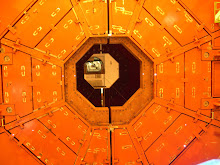 Alan Gillis reports: Use firetrucks. Hai! Concerns by outsiders like physicist Michio Kaku and NewsHammer expanded in The Science of Conundrums, that the Japanese government and the nuclear plant operator, TEPCO have underestimated the scope of the nuclear disaster at Fukushima Daiichi and so have been slow to act, are now confirmed. Unprepared for the unthinkable nothing was done the first day to cool the reactors until 4 hours after the first hydrogen explosion the following day. Overheating spent fuel ponds were ignored until fire hit Unit 4 later. With temperatures and pressures soaring, pumping in sea water was the only option, but it seems TEPCO didn't want to sacrifice Daiichi by ruining what was left of the plant. Now there's less left to worry about. Reminiscent of Chernobyl in this photo of late 1986 at the start of entombment operations.
Alan Gillis reports: Use firetrucks. Hai! Concerns by outsiders like physicist Michio Kaku and NewsHammer expanded in The Science of Conundrums, that the Japanese government and the nuclear plant operator, TEPCO have underestimated the scope of the nuclear disaster at Fukushima Daiichi and so have been slow to act, are now confirmed. Unprepared for the unthinkable nothing was done the first day to cool the reactors until 4 hours after the first hydrogen explosion the following day. Overheating spent fuel ponds were ignored until fire hit Unit 4 later. With temperatures and pressures soaring, pumping in sea water was the only option, but it seems TEPCO didn't want to sacrifice Daiichi by ruining what was left of the plant. Now there's less left to worry about. Reminiscent of Chernobyl in this photo of late 1986 at the start of entombment operations.Using seawater would destroy their multi-billion dollar investment. The Bridge on the River Kwai dilemma, the financial meltdown of TEPCO dilemma, and the political end of the myth of safe nuclear. Not the dilemma of the destruction of life in Japan.
The New York Times article of March 19, 2001 "Executives May Have Lost Valuable Time at Damaged Nuclear Plant" makes a compelling case for more bungling. The house is on fire? Should we use seawater? It will ruin the rugs and furniture.
But consider the four lives lost and other workers at the plant exposed to deadly radiation, the other hydrogen explosions and fires that might have been prevented, if these reactor buildings had been vented in time. The other day TEPCO did do some venting of buildings at risk to prevent hydrogen from collecting inside. Seems big holes were punctured. Why not that first day, before the hydrogen buildup, why not after the first explosion, the second, the third and before the smaller explosions and fires in Unit 4 that threatened its spent fuel pond? Consider the blasts of radioactive smoke and dust and steam released in massive plumes that could have been avoided. If these buildings hadn't been heavily damaged, they would also still act as a considerable barrier to continuing radiation release. Why no safety systems in place to vent these buildings? Why not louvers or vents that could be manually opened when the buildings were intact? Physicists and engineers knew the hydrogen formation/ explosion risks since Three Mile Island. A much more massive containment building there withstood similar explosions.
And now a senior government official admits Japan was caught off guard by the overwhelming scope of the triple disaster, see AP: "Japan official: Disasters overwhelmed government":
Chief Cabinet Secretary Yukio Edano: "In hindsight, we could have moved a little quicker in assessing the situation and coordinating all that information and provided it faster," he said.
More than a week into the meltdown crisis, the experts have failed us over and over again. If Daiichi has shown us anything, once a disaster happens, those in charge not only fail to prevent it, but continue failing. This after last year's Gulf Oil Spill, where BP, the entire oil industry and the US Government were unable to prevent a simple accident, and in the first weeks were totally unprepared to deal with it, preferring to lowball the disaster and see what happens. Start the PR Machine first. Go through the motions. Look concerned.
Is this a repeat? A rerun with new footage and an alternate ending for DVD? So where is the vast Nuclear Industry's vast response to a nuclear emergency? Where is the Task Force that should have been flown in by the IAEA? Where are the Nuclear Navy Seals? Aren't any. A few talking heads on TV. Here is an industry that thinks nothing of spending $5 to $10 Billion on one new nuclear plant, that has a thousand more reactors deployed throughout the world, but won't spend a dollar on an Emergency Strike Force. It's even afraid to stress test its reactors after the stress test at Chernobyl in 1986 that caused the meltdown and radiation destruction of a zone of Ukraine the size of Switzerland.
Nuclear Safety Today: We're Perfectly Safe Until The Next Accident
Physicist Michio Kaku:"Japanese government clueless"
Better to start the Top Kill of Daiichi now, but there is little discussion of a Chernobyl Sarcophagus option and no political will yet to do so. There is some tinkering though like better delivery of seawater via low-tech fire trucks hosing down Daiichi. Will this stabilize the emergency? Yes, somewhat. Steam pressure in reactors that was threatening to explode reactor vessels seems to have eased. Attempting to restore electrical power for electric pumps that may or may not be damaged that also depend on piping that may or may not be damaged, is more problematic. One new electric line to only one unit might be turned on soon once everybody is satisfied that electrical arcing in damaged components and circuits won't occur and spark more hydrogen explosions. But with miles of wiring, how long could that take? In a nuclear hot zone with the Fukushima 50 working in the dark with no power? Though more technicians and engineers are on it, about 300 called in for re-establishing electrical power to Daiichi, but how many of them on site? You might recall remote crisis management from BP Houston in the early days where tremendous but invisible resources were deployed. One cleanup crew one shovel at a time spent half a day in a media glare cleaning a piece of beach for President Obama's press conference. If Obama went to Daiichi we'd get some action. "Weather's kind of hot but we're working on AC for the media trailers as you can see behind me. Plenty of ice-cold Coors if anybody wants some?"
If by a miracle we do get more cooling systems operating, well that's great. Except what's happening to the cooling water. Like hosing down your burning car, the water spills into the street, into the sewers and water table, out to sea, but here it's in tons per hour of dirty radioactive water contaminating the environment. Even if the old closed loop cooling system at Daiichi can be salvaged and its electrical system patched, it's bound to leak with the piping and valves cracked or smashed by the hydrogen explosions and fires. What about a permanent solution? Why not plan for the worst?
No planning to prevent a worst case scenario at Daiichi caused the real damage in the first place that now can't be fixed. It's radiation release. At best the Daiichi Nuclear Disaster can only be contained.
Lessons From Chernobyl
Physicist Michio Kaku: "Catastrophe in the making"
The Chernobyl sarcophagus is now being entertained like an unwelcome guest at Fukushima Daiichi by TEPCO, see Reuters: "Japan weighs need to bury nuclear plant; tries to restore power":
"It is not impossible to encase the reactors in concrete. But our priority right now is to try and cool them down first," an official from the plant operator, Tokyo Electric Power Co, told a news conference.
But some experts in Japan scoff at realistic containment:
"We believe it is not a realistic option," said Hidehiko Nishiyama of the Nuclear and Industrial Safety Agency.
Yeah, why not? He didn't say but other experts don't want to see further damage to the reactor cores and steel vessels reinforced with concrete. Duh? So don't drop heavy sandbags or bags of lead from helicopters. Use parachutes if you're that dumb. Hey, maybe there are other options, like spray your sand and concrete?
Others say encasing the reactors and spent fuel ponds without a cooling system would allow meltdown to continue and perhaps aggravate it like adding an insulation layer to the fire, raising temperatures inside. Yes, but you could go higher tech and allow for heat to travel throughout a thick concrete shell. So you could have passive convection cooling if you did it right. Maybe add a refrigeration plant on top? Why not work on engineering now? Hire Bechtel who designed the new confinement shell for Chernobyl that's under construction. A sarcophagus could stop most nuclear radiation from releasing, though you have to consider the "core on the floor scenario" where the fuel rods could continue their burn through the floor and rock underneath. Instead of officials saying no, better ask the best engineers what can be done. It's not a small problem unless you think that firetrucks can fix it.
Small For Profit Thinking And The Big Picture
And how do we get into these disasters? As long as politicians and CEOs make the ethical decisions for us based on what an oil well or a reactor should cost to be profitable. Engineers are asked to design and build within straitjacket budgets. They see the risks, they warn the client, they warn the operator, they warn their own company, but what do $80,000 guys in hardhats and jeans know? Not as much as suits and ties pulling in $6 million a year and $12 million in perks and options and bonuses, who know they can fire engineers for breakfast.
But there are exceptions. Some engineering firms like Bechtel insist on safety and won't work for nickel and dime clients. They don't cut corners and they don't come cheap. Bechtel has the best safety record in the industry, over 20 million man-hours without a fatal accident. What they build is first class. Contrast that with BP for instance and the BP spill, with hundreds of safety violations on other projects and workers dead and seriously injured since the Texas City Refinery disaster. The stakes at Daiichi are way higher. Daiichi threatens northern Japan and Tokyo, maybe Korea and China.
4,277 Tons Of Nuclear Fuel Can Burn
The scale of the potential disaster of a full meltdown at Daiichi is now clearer, see AP: "Plutonium in troubled reactors, spent fuel pools":
"The Fukushima Dai-ichi site has a considerable number of fuel rods on hand, according to information provided Thursday by Toyko Electric Power Co., which owns the atomic complex: There are 3,400 tons of fuel in seven spent fuel pools within the six-reactor plant, including one joint pool storing very old fuel from units 3 and 4. There are 877 tons in five of the reactor cores. Officials have said that the fuel in Unit 4's reactor vessel was transferred to its spent fuel pool when the unit was temporarily shut in November."
---Although the earlier news on Units 5 and 6, that these 2 reactors had been previously shut down for maintenance as well as Unit 4, suggesting fuel rods had been removed, seems only true for unit 4. So five reactors could melt down as well as 7 spent fuel ponds, for 4,277 tons of fuel rods, with significant levels of extremely dangerous plutonium especially in spent fuel and in the Unit 3 reactor that uses MOX fuel, a mixture of plutonium and uranium. Plutonium which is produced anyway in the other fuel rods in reactors as a by-product, is way more deadly. All 4,277 tons of Daiichi fuel has some plutonium in it. How much they don't say. A pinhead of plutonium can kill a human. How many pinheads in one ton?
Contain the radiation now or more of Japan will be threatened including the world's largest city of Tokyo, only 150 miles away with a total sprawl of 35 million people. Better start design now. It took 6 months of mobilization and engineering to seal just one damaged reactor at Chernobyl in 1986 in a quick and dirty operation that cost many lives, the firemen, the soldiers, the workers on the cleanup and construction. The official numbers of dead at the site and in the hot zone and beyond in Belorussia were lowballed by the PR Machine. Claims today run as high as a million dead. Many are still dying of slow cancers.
Unfortunately the old sarcophagus shell has been cracking for years. The new replacement for Chernobyl containment is taking 4 years to build. Work started last year.
Japan Can't Wait And See
7 Years For The New Chernobyl
With about 50,000 soldiers or half of Japan's army, its Self Defense Forces, devoted to Earthquake/ Tsunami relief and cleanup, it already looks like its entire force will be needed to help its stricken people. For the nuclear emergency too Japan needs massive International Aid, not just a handful of nuclear experts flown in from the IAEA, the US and France.
Japan should ask for the UN to intervene. Japan can't wait and see. A consortium of the world's best engineering firms needs to study Daiichi and how it can be safely sealed, without exposing workers and the general population to lethal radiation. If tinkering fails, without a backup plan, what's the option? Total meltdown? An open nuclear fire pit threatening Japan and its neighbors?
Michio Kaku has said that the possibility of a hydrogen bubble forming at Daiichi and blowing up nuclear cores and nuclear material into the air, is still possible, for another Chernobyl type disaster. The potential in Japan for destruction with 5 reactor cores and 7 spent fuel ponds is up to 12 times the radiation release of Chernobyl. It could kill millions.
Stranger Than Fiction
The Less Horrific BBC Version: Chernobyl 1986
If Japan said yes today, and the best and brightest, the bravest, were on it now, an all out effort could still take months to stop Daiichi. The new entombment of Chernobyl has been an extreme 3 year design and engineering challenge for Bechtel and its partners. How to build on a radioactive hot zone? You don't. Bechtel designed an ingenious solution. Construction after years of bickering on who will pay, is underway to 2013, budgeted at a cost of $1.17 Billion, with delays adding to costs, now $1.4 Billion.
Instead of risking the health of on-site workers in a nuclear hot zone, the project minimizes exposure. A monumental movable arch-like containment building 32 stories high and 3 football fields long will be dragged into place in sections on skid-like roads to secure Chernobyl for the next 100 years. It's an amazing engineering solution from Bechtel that no politician or bureaucrat would dream of.
Still only the second installment on a long nuclear mortgage. The site will be hot for thousands of years to come.
Breaking News from the Japanese PR Machine. Radioactive iodine 3 times normal levels in Iitate tapwater, a village 19 miles from Daiichi. It's "no danger to humans". But don't drink it, according to the same official at the same Japanese Ministry of Health. True story. Is that like Chernobyl isn't dangerous unless you're planning to visit? The gun is not loaded but do not use it for Russian Roulette. To catch a monkey you need a banana?
Updates And Resources
For updates on the International Nuclear Emergency, see The New York Times and check out NYT timelines and interactive features that make it easier to follow what's going on.
The latest NYT The Lede Blog is an overview of major developments.
Here are 3 NYT Interactive Features: The GE Mark 1 Reactor or Deconstructing a Controversial Design, Spent Fuel Poised For Meltdown or Hazards of Storing Spent Fuel, and the Status of the Nuclear Reactors at the Fukushima Daiichi Power Plant.
--Alan Gillis


























No comments:
Post a Comment